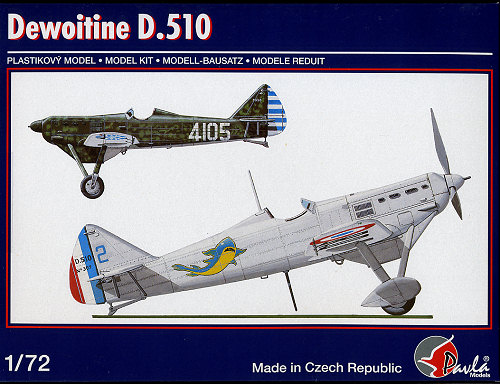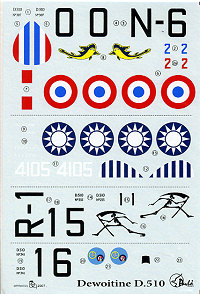
| KIT: | Pavla 1/72 Dewoitine D.510 |
| KIT #: | 72065 |
| PRICE: | $ |
| DECALS: | Four options |
| REVIEWER: | Scott Van Aken |
| NOTES: | Multimedia kit with resin parts and vac windscreen |

| HISTORY |
The D.500, designed by Émile Dewoitine, was based on C1 specifications issued in 1930 by the French Air Ministry, and was to be a replacement for the Nieuport 62. The prototype first flew on 18 June 1932. In November 1933, sixty aircraft were ordered, with the first production D.500 flying on 29 November 1934. Aircraft armed with a 20 mm cannon firing through the propeller hub instead of two nose-mounted machine guns received the designation D.501.
A total of 381 D.500 and its derivatives were built.
The D.500 and D.501 entered service in July 1935, with the more powerful D.510 joining them in October 1936. They were the primary fighters employed by the Armée de l'Air until replacement by the Morane-Saulnier M.S.406 in 1939. As of September 1939, the D.500/501 had been relegated to regional defense and training squadrons. At the start of World War II, D.510s were still in operation with three Groupes de Chasse (Fighter Groups), two Escadrilles Régionale de Chasse (Regional Fighter Squadrons in North Africa), and two Escadrilles de Aéronautique Navale (Naval Aviation Squadrons).
In Morocco, one escadrille of D.510s (ERC571) was activated in November, 1939. These planes lacked cannon. In May of 1940, this escadrille merged with ERC 573 to form GC III/4. This groupe was disbanded by the end of August, 1940. At Dakar, one groupe designated GC I/6, remained in service until being replaced by Curtiss H-75s at the end of 1941.
Seven D.500s originally sold to Lithuania and two D.510s ostensibly intended for the Emirate of Hedjaz saw service in the Spanish Civil War, arriving in mid-1936. When the French government found out about the delivery of D.510s, they demanded return of the 12Y engines. The aircraft were then refitted with Klimov M-100s (a Soviet-built copy of 12Y) from a Tupolev SB bomber. The aircraft served with the Republican forces. The two 510s were posted to the 71st Coastal Defense Group. Neither engaged enemy fighters. In 1938, one was irreparably damaged while landing and the other was destroyed on a runway during a bombing attack.
In 1938, 18 Chinese D.510s saw action against the Japanese, including the defense of Chengdu and Chinese wartime capital Chongqing.
| THE KIT |
 The kit consists of one grey sprue of injected plastic, a number of resin sprues and a pair of vacuformed windscreens. Detailing is engraved as one expects from all modern kits. Now I may have missed this with the last Pavla kit reviewed, but the surface detailing looks reminiscent of some all resin kits I've built in the past. By this I mean that the depth of the panel lines is not always consistent with some fading out near the end of a 'run' and others having some small amounts of 'stuff' in them. All these can be easily fixed by running a scriber over them, but I was somewhat baffled by seeing this. There is also a bit of flash on some parts like the prop blades and the ends of the wings and some of the struts, but really nothing unusu
The kit consists of one grey sprue of injected plastic, a number of resin sprues and a pair of vacuformed windscreens. Detailing is engraved as one expects from all modern kits. Now I may have missed this with the last Pavla kit reviewed, but the surface detailing looks reminiscent of some all resin kits I've built in the past. By this I mean that the depth of the panel lines is not always consistent with some fading out near the end of a 'run' and others having some small amounts of 'stuff' in them. All these can be easily fixed by running a scriber over them, but I was somewhat baffled by seeing this. There is also a bit of flash on some parts like the prop blades and the ends of the wings and some of the struts, but really nothing unusu al. The wheel pants on my example has some areas indented as if someone had taken a hammer and put dents in it. Again, modeling skills will fix that.
al. The wheel pants on my example has some areas indented as if someone had taken a hammer and put dents in it. Again, modeling skills will fix that.
Resin is used for all the detail parts and is very well done. There was some breakage of fragile bits, but that is about it. Basically the interior and all the small detail bits on the outside like aileron hinges and scoops and the such are in resin. There is a set of resin main gear legs in case you wish to do the version without wheel pants. The lower radiator has separate radiator flaps if you wish to build yours 'open' or you can wimp out with the 'closed' piece! Attaching the tiny individual exhaust stubs will require care and a good magnifier. Two different wing armament options are provided. For the French version, you have under wing gun pods. The Chinese aircraft will need holes drilled in the wings for the guns located there. All of the main joins are butt joins but that is pretty typical of these kits.
The instructions are superb and provide all the colors and placement guides you need. Additional drawings are included to be sure you get things properly aligned. Markings are for four aircraft. Two are bare metal/painted aluminum planes with large unit markings on the fuslage from GC II/1 and GC II/8 in 1936-38. A camouflaged GC I/1 aircraft from 1939 is a third option while a camouflaged Chinese plane rounds out the decal options. Decals are superbly done and my experience with Pavla decals has always been very good. Color information is given with Humbrol, Agama and Xtracolor references. I should point out that for some reason the blue is much brighter on the scan than the actual sheet.
| CONCLUSIONS |
Well, if it isn't obvious, you can now retire your Heller D.510 kit to the spares or sales pile as this one eclipses that one in all aspects aside from perhaps ease of construction and I'm not sure it does that from the comments of those who've built the Heller kit. It isn't a big plane, but if pre-war French aircraft are your interest, then this is a definite must have.
| REFERENCES |
June 2007
Thanks toPavla Models If you would like your product reviewed fairly and fairly quickly by asite that has over 350,000 visitors a month, please contactme or see other details in the  . for the review kit. You can get yours direct or from your local hobby store.
. for the review kit. You can get yours direct or from your local hobby store.